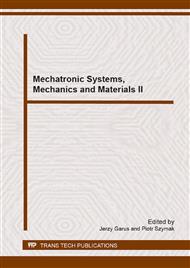[1]
W. Borkowski, P. Rybak, B. Michałowski: Influence of tracked vehicle suspension type on dynamic loads of crew and inside equipment, Journal of KONES Powertrain and Transport, Vol. 13, No. 4, (2006), pp.91-100.
Google Scholar
[2]
P.E. Uys, P. S Els, M. Thoresson: Suspension settings for optimal ride comfort of off-road vehicles travelling on roads with different roughness and speeds, Journal of Terramechanics, vol. 44, Issue 2, April (2007).
DOI: 10.1016/j.jterra.2006.05.002
Google Scholar
[3]
P. Sprawka, The Methods of Evaluation the Mobility of Off - Road Vehicles, Solid State Phenomena Vol 180 2011, pp.355-365.
DOI: 10.4028/www.scientific.net/ssp.180.355
Google Scholar
[4]
Z. Dąbrowski, J. Dziurdz, G. Klekot: Studies on propagation of vibroacoustic energy and its influence on structure vibration in a large-size object, ARCHIVES OF ACOUSTICS Vol. 32 Issue 2, (2007) pp.231-240.
Google Scholar
[5]
M. Amanowicz, W. Kołosowski, P. Gajewski, M. Wnuk: Land mobile communication systems engineering, IEEE Africon: 4th Africon Conference in Africa, (1996) pp.130-133.
DOI: 10.1109/afrcon.1996.563094
Google Scholar
[6]
J. Garus: Power Distribution in Propulsion Systems of Semiautonomous Underwater Vehicle, Mechatronic Systems, Mechanics and Materials Vol. 180, (2012), pp.125-130.
DOI: 10.4028/www.scientific.net/ssp.180.125
Google Scholar
[7]
W. Gierusz: Simulation model of the shiphandling training boat Blue Lady, Control Applications in marine systems, (2002), pp.255-260.
DOI: 10.1016/s1474-6670(17)35092-9
Google Scholar
[8]
Z. Gosiewski: Formation Flight Control Scheme for Unmanned Aerial Vehicles, Robot Motion and Control, Lecture Notes in Control and Information Sciences Vol. 422, (2012), pp.331-340.
DOI: 10.1007/978-1-4471-2343-9_28
Google Scholar
[9]
K. Stefański, Z. Koruba: Analysis of the guiding of bombs on ground targets using a gyroscope systems, Journal of Theoretical and Applied Mechanics Vol. 50, Issue 4, (2012), pp.967-973.
Google Scholar
[10]
J. Lisowski: The optimal and safe ship trajectories for different forms of neutral state constraints, Mechatronic Systems, Mechanics and Materials Vol. 180, Solid State Phenomena, (2012), pp.64-69.
DOI: 10.4028/www.scientific.net/ssp.180.64
Google Scholar
[11]
J. Będkowski, A. Masłowski: Semantic Simulation Engine in Mobile Robot Operator Training Tool, Research and Education in Robotics-Eurobot 2011, Communications in Coputer and Information Science Vol. 161, (2011), pp.40-54.
DOI: 10.1007/978-3-642-21975-7_5
Google Scholar
[12]
W. Mitkowski, A. Obrączka: Simple identification of fractional differential equation, Mechatronic Systems, Mechanics and Materials Vol. 180, Solid State Phenomena, (2012), pp.331-338.
DOI: 10.4028/www.scientific.net/ssp.180.331
Google Scholar
[13]
R. Śmierzchalski: Simulation systems for marine engine control room, Proceedings of the Biennial Baltic Electronics Conference, (2008), pp.281-284.
Google Scholar
[14]
M. Rajewska, M. Walkowiak: Dual-input current-mode gate using for digital signal processing in mechatronic systems, Mechatronic Systems, Mechanics and Materials Vol. 180, Solid State Phenomena, (2012), pp.349-354.
DOI: 10.4028/www.scientific.net/ssp.180.349
Google Scholar
[15]
J. Garus, B. Żak: Using of Soft Computing Techniques to Control of Underwater Robot, 15th International Conference on Methods and Models in Automation and Robotics, (2010), pp.415-419.
DOI: 10.1109/mmar.2010.5587198
Google Scholar
[16]
J. Małecki: Model of Propeller for the Precision Control of Marine Vehicle, Mechatronic Systems, Mechanics and Materials Vol. 180, Solid State Phenomena, (2012), pp.323-330.
DOI: 10.4028/www.scientific.net/ssp.180.323
Google Scholar
[17]
P. Szymak: Comparison of Centralized, Dispersed and Hybrid Multiagent Control Systems of Underwater Vehicles Team, Mechatronic Systems, Mechanics and Materials Vol. 180, Solid State Phenomena, (2012), pp.114-121.
DOI: 10.4028/www.scientific.net/ssp.180.114
Google Scholar


